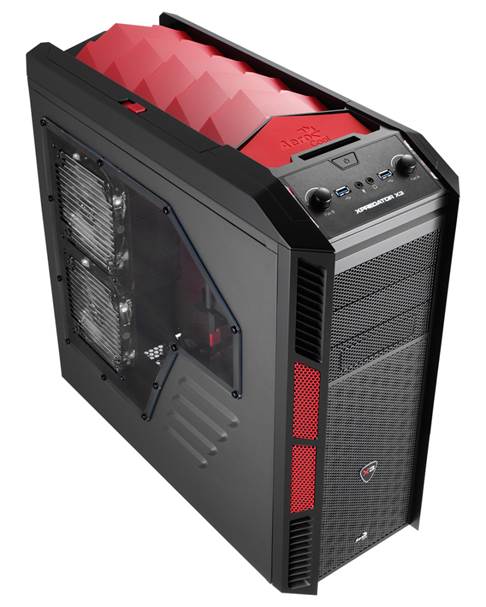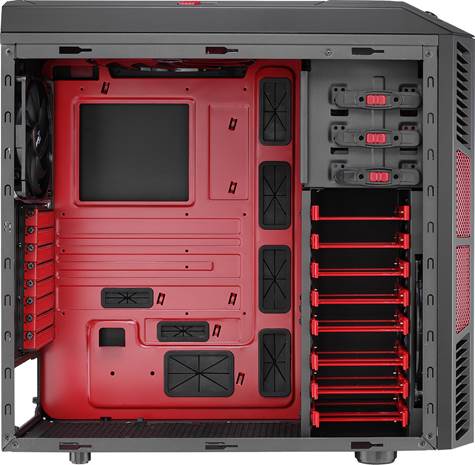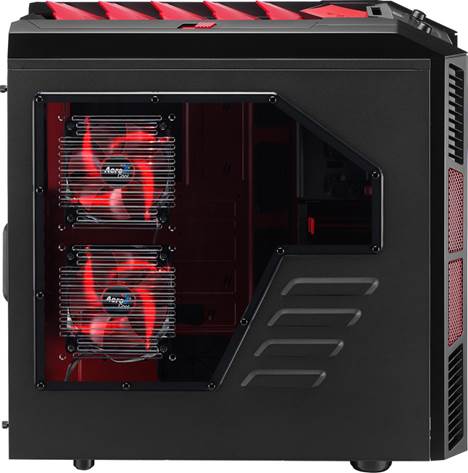A well-built, feature-rich chassis
but the cooling could be better
A quick glance at the Aerocool website
reveals some spectacular designs that resemble the result of a torrid love
affair between a Transformer and a plastic factory. Thankfully, the X-Predator X3
is comparatively refined. Sure, there’s still plastic and lighting, and a dual
color scheme, but it isn’t excessive. The red motherboard tray and drive trays,
viewable through the large side window, are particular highlights.
Whether you love or hate the appearance,
there’s much more to consider than a case’s aesthetics, and the X-Predator X3’s
$120 price point is highly competitive, as the relationship between features,
performance and noise is delicately balanced. The case includes two fans by
default (the extra two shown in the side panel pictured aren’t included), which
is the minimum we’d expect for $120.

Well-built,
feature-rich chassis
The front-mounted 200mm intake fan emits a
soft red glow (the only lighting), alongside a rear 140mm exhaust. There’s room
for seven more fans, though, and the handy ability to add two internal 120mm
fans to the hard drive cage.
As for those looking to water cool their
hardware, the X3 has four holes covered with rubber grommets on its rear for
external setups. There’s little room elsewhere for internal setups, however,
and you’ll be hard-pressed to fit an all-in-one liquid cooler using anything
larger than a dual-fan radiator. In this price bracket, the Corsair Carbide
500R (see Issue 103, p60) is the better case for water cooling on the cheap.
Thankfully, the X-Predator X3 boasts decent
build quality for the money. It’s fairly weighty and difficult to bend or flex
under pressure-even the side panels have very little wobble. The front panel is
a touch too easy to pull off, but the roof panel is fixed tightly. A few areas
let down the overall solid build quality, though. For starters, solid rubber
feet would provide much better grip than the soft foam material on the case
feet. Secondly, the plastic roof vents, which can be opened with a plastic
slider, feel a little flimsy, but it’s otherwise a solid case.

The
case also sports three 5.25in drive bays, one of which has a 3.5in adaptor
Meanwhile, the front panel has a pair of
USB 3 ports alongside the two audio jacks and power button, although oddly
there’s no reset button included. Just behind these connections sits a slanted
red rubber area that could be used to rest a charging phone, for example.
There’s also a neat 2.5in hot-swap dock and a pair of 25Wfan controllers with
variable speed dials, which are excellent inclusions in a chassis at this
price, although you’ll have to connect the fans to the controllers yourself.
Accessing the interior is easy, thanks to
thumbscrews, and doing so reveals a smart and tidy interior. The anti-vibration
rubber spikes and padding around the PSU will help to keep down the noise, and
the lower slide-out dust filter that covers the floor fan mount is a neat touch
too. Further noise-proofing comes from the sound-absorbing foam, although this
is only found on the front panel, where it’s more likely to hinder airflow than
have much impact on noise output.
The case also sports three 5.25in drive
bays, one of which has a 3.5in adaptor. These bays use push-and-slide clips to
hold drives in place, which are incredibly easy to use and provide a secure
fit. Meanwhile, the tool-free rails for the eight non-removable internal bays
hold regular hard drives and SSDs. These use pins to hold the drives in place,
but screws can also be deployed. The trays themselves slide easily into place,
but they’re a little wobbly and ideally should have tighter housing.
We’re pleased to report that cable
management is mostly top-notch in the X3. There’s a host of sensibly placed
cable-routeing holes, including a large one for the 8-pin 12V power connector,
and the grommets used to cover the holes are fitted securely. Our only gripe is
the fairly cramped space behind the motherboard tray. It’s adequate for hiding
cables, but a few extra millimeters of space would go a long way. Thankfully,
Aerocool also provides numerous hooks and zip ties for you to keep your cables
fastened flat against the motherboard tray.
Cooling
With the X3’s fans set to their lowest
speeds, the case remains very quiet indeed. Temperatures suffer as a result,
however. ltsCPUdeltaTof57°C isn’t the highest we’ve seen, but it looks toasty next
to other cases in the same price bracket. Having a rear exhaust fan is always
beneficial to CPU temperatures, but less so when the airflow is so low. The GPU
delta T of 53°C is also up there with the warmest cases.
Although noise levels increases lightly
when you turn up the fans to their full speed, the case remains quiet. The
result is a 2°C drop to the delta T results for both the CPU and GPU - a
smaller variance than we’re used to seeing between minimum and maximum speeds.
The new delta T results are better, but still not very impressive, particularly
for the GPU-we’ve seen these figures matched or bettered by other low-noise
cases in the same price league, such as the CorsairCarbide500R.

provide
a greater range between high airflow cooling, and low air flow and low noise
Conclusion
With the inclusion of noise-dampening foam,
low-speed fans and fairly high temperatures, the X-PredatorX3 has all the
hallmarks of a low-noise chassis. However, this is juxtaposed with its bold
styling and large side window, suggesting it’s targeted at those who care more
about performance and noise.
We have few niggles with the construction
and design, though, and its feature set is impressive for an $120,9chassis.
There’s also plenty of room to upgrade the default cooling on offer if you like
the case’s looks. That said, given the inclusion of variable speed fan
controllers, it would have made far more sense for Aerocool to have used fans
capable of reaching higher speeds, to provide a greater range between high
airflow cooling, and low air flow and low noise.
|
Info
§
Price: $120
In Detail
§ Dimensions
(mm): 223 x 533 x527 [WxDxH]
§ Material:
Steel, plastic
§ Available
colors: Black, red, white
§ Weight:
8.66kg
§ Front
panel: Power, 2x USB 3, stereo, mic
§ Drive
bays: 2xexternal 5.25in drive bays, external 5.25in/3.5in drive bay, external
hot-swap 2.5in drive bay, 8x internal 3.5in/2.5in drive bays
§ Form
factor(s): ATX, micro-ATX mini-ITX
§ Cooling:
1x200mmfrontfan mount (fan supplied), 1 x 140mm/120mm rear fan mount (140mm
fan supplied), 2 x U0mm/120mm side fan mounts, 1x200mmor2x U0mm/120mm roof
fan mounts, 1xU0mm/120mm bottom fan mount, 2x120mm internal fan mounts
§ CPU
cooler clearance: 186mm (without side fans)
§ Maximum
graphics card length: 310mm
|